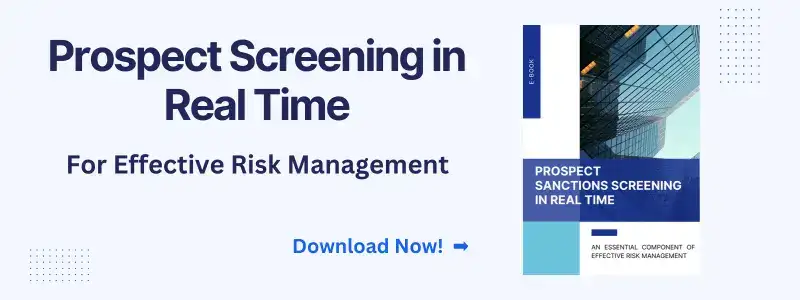The Ultimate Guide to Payment Screening in AML Compliance
Payment screening is a crucial process in the world of finance and banking, aimed at ensuring compliance with anti-money laundering (AML) regulations and detecting potential fraudulent transactions. By analyzing incoming and outgoing payments, payment screening enables financial institutions to verify the legitimacy of payment information and credentials, as well as identify and escalate any suspicious activities for further investigation.
What is Payment Screening?
Let's start by making it simple. Imagine you're at a concert entrance, and there are security folks checking everyone's bags and tickets. Well, payment screening is sort of like that but for money moving around in the digital world. It's a check to make sure that the payment you're making or receiving isn't sketchy or breaking any rules. So, for businesses and especially financial institutions, it's a must-have to ensure they're not accidentally helping out with illegal activities like money laundering.
How Does the Payment Screening Process Work?
Remember the security check example? In the world of finance, this screening isn't done by people but by super-smart computer programs. When a payment is about to be made, the software springs into action. It checks the names, the amount, the place it's coming from, and where it's going. If something looks fishy, it sets off an alarm, and human beings take over to examine it more closely.
The Payment Screening Process
The payment screening process involves several steps to effectively verify payment information and detect any potential risks or violations of regulatory standards. Let's explore each step in detail:
Step 1: Data Collection and Validation
The first step in the payment screening process is to collect and validate the necessary data from both incoming and outgoing transactions. This includes gathering information such as transaction amounts, sender and receiver details, geographic locations, and any additional relevant data points. It is essential to ensure the accuracy and completeness of the collected data to enable effective screening and analysis.
Step 2: Customer Authentication and Verification
Once the data is collected and validated, the next step is customer authentication and verification. This involves confirming the identity of the individuals involved in the transaction and verifying their credentials. Financial institutions often employ various techniques and technologies, such as Know Your Customer (KYC) procedures and identity verification tools, to ensure the legitimacy of the parties involved.
Step 3: Risk Assessment
After customer authentication and verification, the payment screening process moves on to risk assessment. This step involves evaluating the potential risks associated with the transaction, including the likelihood of fraud or money laundering. Risk assessment may consider factors such as transaction patterns, historical data, geographic locations, and any red flags identified during the authentication process.
Step 4: Name Screening Against Sanctions Lists
A critical aspect of payment screening is name screeningagainst sanctions lists. Financial institutions are required to cross-reference the names of individuals or entities involved in the transaction with various sanctions lists. These lists typically include individuals, organizations, or countries associated with illegal activities or deemed high-risk by regulatory authorities. By conducting name screening, financial institutions can ensure compliance with regulatory standards and avoid facilitating transactions involving sanctioned entities.
Step 5: Escalation and Investigation
If any suspicious activities or potential violations are identified during the payment screening process, the next step is escalation and further investigation. Financial institutions have dedicated teams and processes in place to review and analyze flagged transactions in more detail. This may involve gathering additional information, conducting enhanced due diligence, and collaborating with law enforcement or regulatory agencies if necessary.
Step 6: Reporting and Compliance
Lastly, the payment screening process includes reporting and compliance. Financial institutions must maintain proper documentation of their screening activities and any actions taken in response to identified risks or violations. This information is crucial for audits, regulatory compliance, and demonstrating a commitment to AML and fraud prevention.
Importance and Benefits of Payment Screening in AML
Why all this fuss? Well, it's the law! Anti-Money Laundering (AML) rules require this type of screening to stop bad guys from moving around money they shouldn't have. But it's not just about being law-abiding. Payment screening helps in identifying risks early on. For example, if a payment is coming from a place known for illegal activities, it's better to know that before the money hits your account, right?
Benefits of Payment Screening
Implementing an effective payment screening process offers several benefits for financial institutions:
AML Compliance
Payment screening plays a vital role in ensuring AML compliance. By verifying customer identities, conducting risk assessments, and screening against sanctions lists, financial institutions can prevent money laundering and comply with regulatory standards. Failure to comply with AML regulations can result in hefty fines and reputational damage for institutions.
Fraud Detection and Prevention
Effective payment screening helps financial institutions detect and prevent fraudulent activities. By analyzing transaction patterns, conducting risk assessments, and cross-referencing names against sanctions lists, suspicious transactions can be identified and escalated for further investigation. Prompt detection of fraud can mitigate financial losses and protect both the institution and its customers.
Enhanced Security
Payment screening enhances the overall security of financial transactions. By authenticating customers, verifying their credentials, and analyzing transaction data, institutions can ensure that only legitimate transactions are processed. This helps protect customers' funds and sensitive information, reducing the risk of unauthorized access or fraudulent activities.
Reputation Management
Maintaining a strong reputation is very important for financial institutions. Implementing robust payment screening processes demonstrates a commitment to compliance, security, and fraud prevention. This builds trust among customers, regulators, and other stakeholders, contributing to a positive reputation in the industry.
Difference Between Payment Screening and Transaction Monitoring
You may think that payment screening is the same as transaction monitoring, but they are like cousins, not twins. Payment screening is the bouncer at the door, checking everyone coming in. Transaction monitoring, on the other hand, is like a security camera inside the venue, observing what's happening during the event. Payment screening stops the suspicious activity before it happens, while transaction monitoring keeps an eye on the money once it's already in the system.
Understanding Payment Screening Vs Transaction Monitoring
While payment screening and transaction monitoring share the common goal of analyzing transactions, they serve different purposes in the financial industry. Transaction monitoring primarily focuses on real-time or retroactive analysis to detect and prevent fraud and money laundering. On the other hand, payment screening is more closely associated with AML compliance and customer authentication and verification.
As real-time payment services gain popularity, the need for both real-time monitoring and screening becomes increasingly important. While transaction monitoring analyzes customer transaction patterns to identify anomalies that may indicate suspicious activity, payment screening focuses on verifying customer identities. It takes into account factors such as geographic location and the devices used by the sender and receiver. Additionally, payment screening involves name screening against sanctions lists to ensure compliance with regulatory standards.
Payment screening is typically conducted at specific moments in a customer's lifecycle, such as during the onboarding process or after updating identification documentation. In contrast, transaction monitoring is an ongoing process that continuously analyzes transactions for potential risks.
Final Words
Just like you wouldn't let just anyone into your house, financial companies shouldn't let just any payment through their systems. Payment screening acts like that diligent security guard, making sure that only the good stuff gets through and that you stay on the right side of the law.
Payment screening is a critical process that financial institutions must undertake to ensure AML compliance, detect and prevent fraud, and enhance transaction security. By implementing effective payment screening processes, institutions can verify payment information, authenticate customers, assess risks, and identify suspicious transactions.
This not only helps institutions comply with regulatory standards but also protects their reputation and the interests of their customers. As the financial landscape evolves, payment screening remains a vital component of a comprehensive AML and fraud prevention strategy.
Frequently Asked Questions (FAQs)
What is the difference between name screening and payment screening?
Name screening is like checking the guest list at a party, focusing mainly on the names involved in a transaction. Payment screening is more thorough; it's like checking not only the guest list but also their bags and their car's trunk!
What type of screening is conducted on payments?
Payment screening involves multiple checks like verifying names, scrutinizing the amount, and assessing the risk level based on where the payment is coming from and going to.
How often is payment screening done?
Payment screening is conducted in real-time or batch mode, depending on the institution's setup, every time a payment is initiated or processed.
Is payment screening mandatory for all businesses?
While payment screening is not legally mandatory for all businesses, it is highly recommended for financial institutions and firms that handle large or international transactions to comply with AML laws.
Can payment screening detect fraud?
Yes, payment screening can identify potentially fraudulent transactions by flagging irregularities, but it is just one part of a comprehensive fraud prevention strategy.
Anti-Financial Crime Compliance with Tookitaki?






